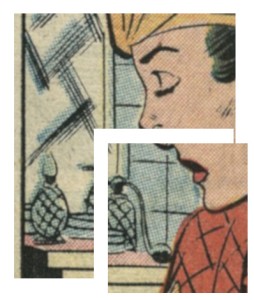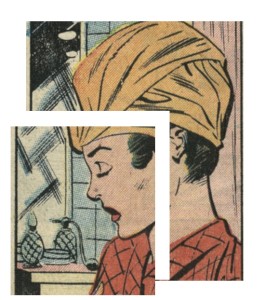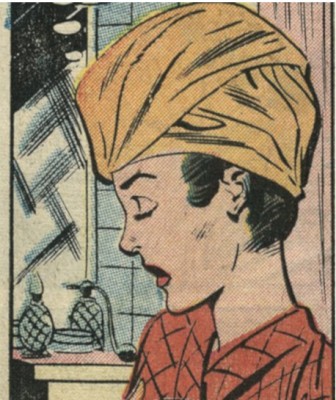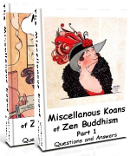Mumonkan Koans - Introduction
48 Koan Questions - 48 Koan Answers

Koan: Who are you?
The Wumen Guang (jap. Mumonkan) is a text-book of Buddhism with 48 stories about the world-view of Chan (jap. Zen) in 13th century China.
Master Wumen HuiKai's (jap. Mumon) stories are some kind of riddles, most Zen students have to solve until today.
Unlike the short, undated, ancient Koans, Wumen's stories, the Guang, are about Chinese Master who lived between 5th and 12th century in different parts of China.
You find a list of these stories, called "Koans" in Japan, at the right hand side further down the page. Just click on some of them to see some Koans and their answers! Strange aren't they?
Wumen's text-book of Chan Buddhism was hardly used in China although it had the approval of the emperor. When the book came to Japan in 13th century it was called "Mumonkan" but again only valued for some decades. As late as in early 18th century the Mumonkan became an important text in Japanese Zen education.
Master Wumen HuiKai's (jap. Mumon) stories are some kind of riddles, most Zen students have to solve until today.
Unlike the short, undated, ancient Koans, Wumen's stories, the Guang, are about Chinese Master who lived between 5th and 12th century in different parts of China.
You find a list of these stories, called "Koans" in Japan, at the right hand side further down the page. Just click on some of them to see some Koans and their answers! Strange aren't they?
Wumen's text-book of Chan Buddhism was hardly used in China although it had the approval of the emperor. When the book came to Japan in 13th century it was called "Mumonkan" but again only valued for some decades. As late as in early 18th century the Mumonkan became an important text in Japanese Zen education.
Content

First Koan answer
Box two: In Japan playful Chinese Chan became mystical Zen
Box three: Find a Koan Solution by yourself!
Box four: The presentation of the Koan cases
Box five: How to find a Koan of Mumonkan?
Box one: Guang - the World-View of Chinese Chan Buddhism
The world-view of Chinese Buddhism is simple and uncomplicated to learn by answering Wumen's Guang-riddles.

Second Koan answer
But read Wumen's riddles like a child and react on them in this way. A child takes the world for granted. Every"thing" is simple, and if it's not, it's made simple. Every"thing" has a name. That's it.
A child won't understand most of Wumen's complicated stories. But very often there's a detail, a child would like to keep in mind, a plant, an animal, something to cry or something to laugh.
The Buddhist mind in Chinese Chan expresses itself in a playful simplicity.
The teachings of the Buddha, scientific knowledge, history and culture are not essential.
Explore the simple Chan-Buddhist world-view. It's the medieval Chinese way to enlightenment!
back to content
The 48 Koans of Master Wumen HuiKai (jap. "Mumon")
Click on the title to see question and answer.
Click on the number to see the full Koan-page.
1 Joshu's Dog
2 Hyakujo's Fox
3 Gutei's Finger
4 Beardless Bodhidharma
5 Kyogen's Man in a Tree
6 Buddha Twirls a Flower
7 Joshu's Wash your Bowl
8 Keichu's Wheel
9 A Buddha before History
10 Seizei Alone and Poor
11 Joshu Examines two Hermits
12 Zuigan Calls Himself Master
13 Tokusan Holds His Bowl
14 Nansen Cuts the Cat in Two
15 Tozan's Three Blows
16 Bells and Robes
17 The Three Calls Of The Emperor's Teacher
18 Tozan's Three Pounds of Flax
19 Everyday Life Is The Path
20 The Enlightened Man
21 Dried Dung
22 Kashyapa's Preaching Sign
23 Do Not Think Good, Do Not Think Not-Good
24 Without Words, Without Silence
25 Kyozan Preaching in a Dream
26 Two Monks Roll Up The Blinds
27 It Is Not Mind, It Is Not Buddha, It Is Not Things
28 Blow Out The Candle
29 Not The Wind, Not The Flag
30 This Mind Is Buddha
31 Joshu Investigates an Old Woman
32 A Philosopher Asks Buddha
33 Baso's Not Mind, Not Buddha
34 Nansen's Knowledge is not The Way
35 Two Souls
36 Meeting A Master On The Road
37 The Oak Tree In The Garden
38 A Buffalo Passes Through The Window
39 Ummon's Trapped in Words.
40 Tipping Over A Water Jug
41 Bodhidharma Pacifies The Mind
42 The Girl Comes Out From Meditation
43 Shuzan's Short Staff
44 Basho's Staff
45 Who Is He?
46 Step Forward from fhe Top of the Pole
47 First Gate Of Tosotsu
47 Second Gate Of Tosotsu
47 Third Gate Of Tosotsu
48 Kembo's One Road To Nirvana
Click on the title to see question and answer.
Click on the number to see the full Koan-page.
1 Joshu's Dog
2 Hyakujo's Fox
3 Gutei's Finger
4 Beardless Bodhidharma
5 Kyogen's Man in a Tree
6 Buddha Twirls a Flower
7 Joshu's Wash your Bowl
8 Keichu's Wheel
9 A Buddha before History
10 Seizei Alone and Poor
11 Joshu Examines two Hermits
12 Zuigan Calls Himself Master
13 Tokusan Holds His Bowl
14 Nansen Cuts the Cat in Two
15 Tozan's Three Blows
16 Bells and Robes
17 The Three Calls Of The Emperor's Teacher
18 Tozan's Three Pounds of Flax
19 Everyday Life Is The Path
20 The Enlightened Man
21 Dried Dung
22 Kashyapa's Preaching Sign
23 Do Not Think Good, Do Not Think Not-Good
24 Without Words, Without Silence
25 Kyozan Preaching in a Dream
26 Two Monks Roll Up The Blinds
27 It Is Not Mind, It Is Not Buddha, It Is Not Things
28 Blow Out The Candle
29 Not The Wind, Not The Flag
30 This Mind Is Buddha
31 Joshu Investigates an Old Woman
32 A Philosopher Asks Buddha
33 Baso's Not Mind, Not Buddha
34 Nansen's Knowledge is not The Way
35 Two Souls
36 Meeting A Master On The Road
37 The Oak Tree In The Garden
38 A Buffalo Passes Through The Window
39 Ummon's Trapped in Words.
40 Tipping Over A Water Jug
41 Bodhidharma Pacifies The Mind
42 The Girl Comes Out From Meditation
43 Shuzan's Short Staff
44 Basho's Staff
45 Who Is He?
46 Step Forward from fhe Top of the Pole
47 First Gate Of Tosotsu
47 Second Gate Of Tosotsu
47 Third Gate Of Tosotsu
48 Kembo's One Road To Nirvana
Box two: In Japan playful Chinese Chan became mystical Zen
In 13th century the Japanese Master Dogen studied with Wumen in China and brought with him a copy of the Wumen's Guang book. It became known in Japan as "Mumonkan". Dogen worked with them the Chinese way.

Third Koan answer
In 18th century Hakuin revived the Koan practice. By hiding the punch-line of the riddles, their mystification was increased and a "solution" (answer) has to be found.
Todays Zen made the process of answering Koans a ritual. The mystical Koan answer has to be "seen through", its a "spiritual experience" when approved by a master.
The Chinese purpose of Wumen's collection to train a simple and undisturbed mind-set is gone. To clear the mind from all unnecessary worldly theories and complications etc. is still appreciated but only as it's explained your teacher.
back to content
Box three: Find a Koan solution by yourself!
For each Koan riddle you find an answer on the right hand side. If that's all you're looking for, you're done.
It's quite another story, if you are with a Zen-teacher who want's you to "work" on Koans.
If you use one of the answers of this site, it may not work.

Fourth Koan answer
But how to find another Koan answer?
Just a short guide.
All of Wumen's riddles basically ask the same question: Who are you?
That's neither a philosophical nor a every-day-life question. That made it so difficult in mediavial times.
Today we know everybody is the result of evolution and her genetic code.
Everybody's code is unique, inherited from parents and grandparents, grand-grandparents and further down in history and evolution.
Your code even shares some genes with animals, with plants and other forms of live.
Genes are made from non-living material, that connects us to this planet, to the universe.

Fifth Koan answer
Sometimes "you" are changed into a tree, a wooden stick or a flower.
These "things" represent "you" in the Koan-story. Do what's told about "you" in the story. That's it.
Zen teacher traditionally reject any Koan-answer you give.
Don't bother about that.
This changes only after you're "exhausted" by your "desparate" efforts.
It needs a bit of "training" to show a convincing mindset of "desparation". Do it emotionally! Crying is helpful.
Play the encounter as slapstick. Be creative, alive.
Be careful. Don't forget, Zen-teacher need to stay on top of the food-chain, poor guys.
back to content
Box four: The presentation of the Koans cases
The number and the headline of each case comes first.
The Koan-question is the core of every Koan. It's on top of the Koan picture. The pictures caption is the Koan answer.

Last Koan answer
The first part is a short explanation of the Koan answer.
The second part is the background story. Sometimes the background is part of the Koan itself. Sometimes the background story comes from other sources.
The third part is a different, more literal translation of the Koan, closer to the original with Chinese names for places and people.
This translation is often helpful to better understand the meaning and the social context of a Koanstory.
The fourth part provides Wumens commentary to the Koan, again in two English translations.
One from the Japanese translation, the other closer to the Chinese original.
Each Koan has a Poem (Gata) which are in the fifth part, a gata in Japanese translation and a gata closer to the original Chinese text.
back to content
Box five: How to find a Koan of Mumonkan?
There're several ways to find a Koan you're interested in.
The easiest is, to go down the list of Koan headlines on the right hand side.
If you find an interesting one. Just click on it and the Koan question as well as its answer is available for you.
If you want more information click the number of a Koans and you'll see the full Koan-page.
All Koans are in their traditional numerical order.
For all Koans is more information available.
Click the number of a Koans and you'll see the full Koan-page.
Today's Zen is Japanese Zen. Chinese Chan Buddhism isn't alive any more.
Therefore Japanes Names of Masters and places are used in the list of Koans.
The Chinese names and an English translations of the full Koan-text can be found at the extended versions of each of Mumons Koans.
back to content
There're several ways to find a Koan you're interested in.
The easiest is, to go down the list of Koan headlines on the right hand side.
If you find an interesting one. Just click on it and the Koan question as well as its answer is available for you.
If you want more information click the number of a Koans and you'll see the full Koan-page.

Koan: Who are you?
All Koans are in their traditional numerical order.
For all Koans is more information available.
Click the number of a Koans and you'll see the full Koan-page.
Today's Zen is Japanese Zen. Chinese Chan Buddhism isn't alive any more.
Therefore Japanes Names of Masters and places are used in the list of Koans.
The Chinese names and an English translations of the full Koan-text can be found at the extended versions of each of Mumons Koans.
back to content
Go to List of all Mumonkan Cases
Go to Ancient Zen Koans
Go to Zen Riddles
Return to Home Page from Mumonkan



